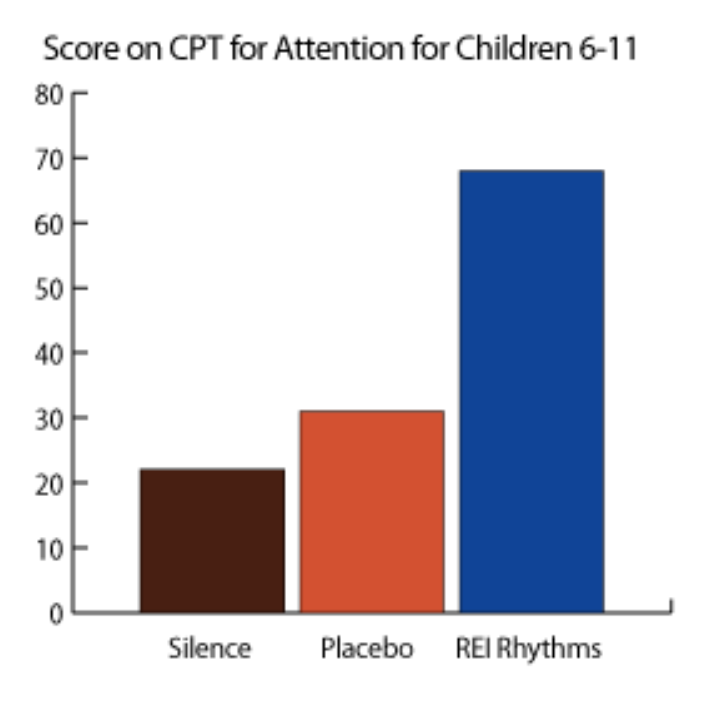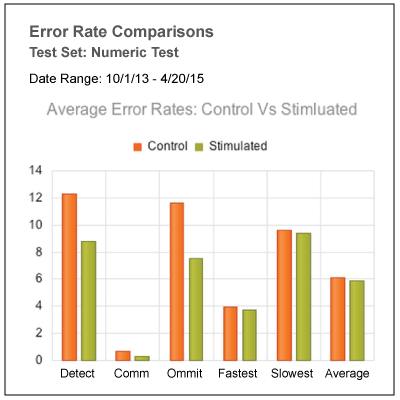Brain Stim Audio Increases Focused Attention
Focus is our most popular category and, coupled with our Brain Boost category, represents almost half of all music listened to on Brain Stim Audio.
We began working on focus and attention in the early 1990s with several studies on Attention Deficit Disorder in both children and adults.
Brain Stim Audio is designed for immediate episodic results. It is simple to use and exceptionally inexpensive. And because BSA customizes the stimulation based on your needs and feedback, we can offer some great focusing effects, regardless of how well you focus, to begin with.
To obtain results for improving your focus simply create an account, choose the Focus category, and answer the intensity question.

Aside from using our CPT data to increase user focus, these tests also encourage engagement, an important component in achieving sustained use and improved gains.
Independent Studies Show BSA Music Improves Attention
Two recent independent third-party studies examined the core techniques used for BSA music, Rhythmic Entrainment Intervention (REI), to increase focused attention. One study compared BSA music to the AD/HD stimulant medication, Ritalin, using a Continuous Performance Test (the T.O.V.A.) for an adult with Attention Deficit Disorder while the other study used a blinded placebo-controlled format for elementary-age children in a classroom setting.
BSA Music Beats Ritalin for Sustaining Attention in an Adult with ADD
This study (1) compared BSA’s music to two different doses of the ADD stimulant medication, Ritalin (10mg and 20mg). Using quantitative measures of scores from the Test of Variables of Attention (T.O.V.A.), four conditions were examined: Baseline (no meds or music), 10mg of Ritalin taken 90 minutes before the test, 20mg of Ritalin taken 90 minutes before the test, and while listening to REI music rhythms.

The subject’s baseline score was -12.74, putting him squarely in the AD/HD camp (anything below a score of 0.00 suggests attention problems).
His score with 10mg of Ritalin was a slightly improved -6.60 while his 20mg Ritalin score showed a significant improvement with a score of -3.47.
His score when listening to the REI focusing music, the same tracks you will find in the Focus category of Brain Stim Audio, was a near normal score of -1.87.
This improvement was nearly 50% greater than the better of the Ritalin scores.
These results suggest that REI offers a strong alternative to Ritalin (and other stimulant medications used for ADD).
The advantages of BSA music include an absence of side-effects, individual customization to achieve the optimal stimulation level for each person, and improved sustained attention.
REI Drumming Improves Concentration in Elementary School Children
The results showed a significant improvement in attention for those who listened to the REI recording over both the silence and placebo conditions. The silence group produced an average score of 23, the placebo group scored 31, and the REI Rhythm group scored an average of 68.
These results have been encouraging enough that Brain Stim Audio has invested tremendous time and energy in developing a next-level study to further explore the efficacy of REI rhythms and the delivery of BSR music.

BSA's Attention Tests Move Music Research a Step Forward
With our Continuous Performance Test, we are moving music research forward by conducting the largest study ever done on music for focusing.
Our attention tests were built using standardized, quantitative testing methods on an expanding platform which will allow us to collect and analyze limitless data with the goal of using this data to not only determine whether music can improve focused attention but also which techniques offer the most significant results for each population group.
Thousands of Tests = Some amazing results
Since we launched the BSA CPT initiative thousand of people have taken the test. The results we’ve seen are 3.6 times better than the most popular study on music for cognition (and the number of people who have taken our test is hundreds of times more than this study) (3).
These are significant numbers and suggest that listening to Brain Stim Audio when you need to focus may help you sustain your attention.
We saw reductions in all three error rates – detection, commission, and omission – with the BSA music (stimulated) condition compared to the silence (control) condition.
Detection errors (Detect): The silence (control) condition error rate was 12.42. The BSA music (stimulated) condition showed an error rate of 8.69. This is a 3.73 or 30.0% reduction of errors.
Commission errors (Comm): The silence (control) condition error rate was .73. The BSA music (stimulated) condition showed an error rate of .39. This is a .34 or 46.5% reduction of errors.

Omission errors: The silence (control) condition error rate was 11.58. The BSA music (stimulated) condition showed an error rate of 7.67. This is a 3.91 or 33.7% reduction of errors.
Fastest click: For the silence (control) condition the fastest click speed was 383 ms. The BSA music (stimulated) condition showed an average click speed of 355 ms (milliseconds). This is a 28 ms or 7.3% slower click-time.
Slowest click: For the silence (control) condition the slowest click speed was 968 ms. The BSA music (stimulated) condition showed an average click speed of 932 ms. This is a 36ms or 3.7% faster click-time.
Average click: Of the three click speeds the average offers us the best data. For the silence (control) condition the average click speed was 608 ms. The BSA music (stimulated) condition showed an average click speed of 579 ms. This is a 31 ms or 5.1% faster click-time.
Music and Cognition Project
The framework we built for Brain Stim Audio was designed to allow researchers to explore the effects of music on attention with ever-expanding and filtered datasets with any music. Researchers can compare BSR music to silence. Mozart to silence, Mozart to BSA, BSA to heavy metal, and so on. All the while we’re capturing data about gender, age, and perceived focusing abilities. And we’re able to compare repeat users’ results over time.
All this data not only helps us understand the ability of music to improve attention but also helps us improve our music to deliver even better results.
Researchers: Contact us about using our CPT infrastructure for your studies.
Brain Stim Audio’s path as a leading-edge music research organization will continue to provide the most powerful, cost-effective tools for improving focused attention.
Note: Data used for these studies will be anonymous and will comply with IRB and HIPAA requirements for client privacy and research integrity.
Sources:
1. A Study for Improved Concentration by Acoustic Drum Rhythms Music Medicine Therapy
2. REI Rhythms Beat Ritalin for an Adult with Attention Deficit Disorder
3. Mozart Effect
